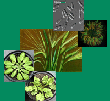| Riber, W; Müller, JT; Visser, EJ; Sasidharan, R; Voesenek, LACJ; Mustroph, A: The greening after extended darkness 1 is an N-end rule pathway mutant with high tolerance to submergence and starvation, Plant Physiology, 167(4), 1616-1629 (2015), doi:10.1104/pp.114.253088 | |
| Abstract: Plants respond to reductions in internal oxygen concentrations with adaptive mechanisms (for example, modifications of metabolism to cope with reduced supply of ATP). These responses are, at the transcriptional level, mediated by the group VII Ethylene Response Factor transcription factors, which have stability that is regulated by the N-end rule pathway of protein degradation. N-end rule pathway mutants are characterized by a constitutive expression of hypoxia response genes and abscisic acid hypersensitivity. Here, we identify a novel proteolysis6 (prt6) mutant allele, named greening after extended darkness1 (ged1), which was previously discovered in a screen for genomes uncoupled-like mutants and shows the ability to withstand long periods of darkness at the seedling stage. Interestingly, this ethyl methanesulfonate-derived mutant shows unusual chromosomal rearrangement instead of a point mutation. Furthermore, the sensitivity of N-end rule pathway mutants ged1 and prt6-1 to submergence was studied in more detail to understand previously contradicting experiments on this topic. Finally, it was shown that mutants for the N-end rule pathway are generally more tolerant to starvation conditions, such as prolonged darkness or submergence, which was partially associated with carbohydrate conservation. |

